There’s a lot to say about South Figaro, considering it’s a totally optional space in this portion of the game. However much time you spend there, though, all roads will eventually lead you to Mt. Kolts, the path leading to your next story objective: The base of the rebellious Returners. Coincidentally, a new party member happens to be hanging out along the way. It’s a small world.
Although, in fairness, Mt. Kolts makes the world somewhat larger than it has been until this point. Every area you’ve visited to here in Final Fantasy VI — Narshe, its caves, Figaro Castle, its caves, and South Figaro — are places to which you will eventually return. As such, every part of the game you’ve seen until now has an unusual amount of substance and a remarkable number of inaccessible features (such as, for example, pretty much the entirety of Narshe). With Mt. Kolts, however, this is it. Blink and you’ll miss it, because there’s no good reason to come back this way unless you really screw up with some of the one-way transit features within the world.

The theme of the caves of Mt. Kolts is “martial arts.” Several people in South Figaro mention the fact that local martial arts master Duncan likes to hang out in this area, and that probably accounts for the fact that most of the enemies in the interior portions of this region are kung fu dudes named Zaghrem. An interesting fact about these guys is that — although there’s no way for you to know this without hacking the game’s data — Zaghrems are always under Berserk status. (Though the fact that they have red faces could be meant as a tip-off; berserk status causes party members to become tinted with red.) This means they always use physical attacks rather than any of their special abilities, and they hit harder than their base stats would suggest. In practice, this is completely opaque to the player, though; enemies in this game almost always attack a target at random (one of the factors of the berserk condition), and since you never see any of their alternate techniques, it makes no nevermind anyway.
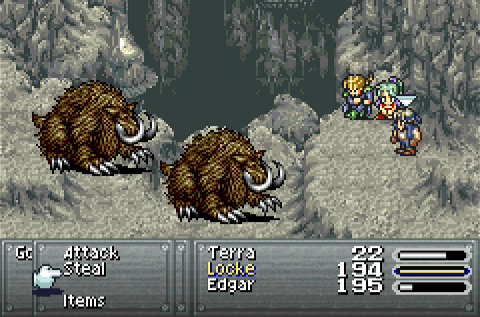
The other encounter inside the caves of Mt. Kolts are these mammoths called Gorgias, which use a powerful counterattack to physical strikes. Like Zaghrems, Gorgiases are much more powerful than enemies you’ve faced until this point. If you bought a Knight’s Code in South Figaro, it’ll probably get a workout here at some point or another. But the real point of these enemies is to help reinforce the importance of not just mashing “Attack” over and over again — special abilities like Tools and Magic aren’t simply powerful, they also don’t trigger counters.

The layout of Mt. Kolts is quite involved, though; in addition to the caves, it also consists of outdoor spaces that you need to traverse in order to advance. This allows the layout of the “dungeon” to be fairly complex without being too confusing; the caverns and hillsides alternate, creating visual variety that makes it much easier to keep track of your progress and not become lost. Compare Mt. Kolts to the previous dungeon, which was much smaller but more confusing due to its monotony. There’s only so much a game with 24Mb of data and so much ground to cover can provide in terms of visual variety, so the designers compensated here by mixing up the layouts between two different tile sets.
Also, a mysterious shadow appears a couple of times, vanishing into the background ahead of you. How strange!

And the mountain pass really does get intricate: You’ll spot inaccessible chests and out-of-the-way entrances along the route, prompting you to explore as much as possible. You can find the main path through the dungeon easily enough, but when you’re taunted by chests like this, you’re more likely to take the time to poke around for alternate routes and even backtrack if you miss something.

In the outdoor spaces, you won’t encounter any martial artists; instead, you’ll encounter much more varied creatures with some unique traits. Trilliums, the green-and-purple plants, introduce you to poison status: There’s a one-in-three chance Trilliums will use an attack that causes its target to become poisoned. You’ve potentially seen poison in action against bad guys thanks to Bio Beam and the Bio Blaster, but this is the first time it’s been directed at your party. Poison does the same thing to player characters as to bad guys, but there’s an important difference: It sticks. While poison basically just helps you kill bad guys faster, it’s a long-term irritant when used against you. Poison doesn’t disappear at the end of a battle, and any affected character will continue to have their health sapped as they walk outside of battle until you use an Antidote or Terra’s Poisona spell.
That’s something worth mentioning: As Terra levels up, she occasionally learns new spells. The first additional spell she gains beyond her starting point is Poisona, which clears up Poison status in one target either in or out of battle. It’s essentially an Antidote, but it operates on Magic Points rather than being a consumable item.

The enemies in Mt. Kolts’ outdoor areas tend to attack in fairly large numbers, which makes Edgar’s Noiseblaster useful; it inflicts confusion status, which causes enemies to attack one another. Against large groups of enemies, it offers a good, cheap way to minimize the number of attacks they direct toward the party. Edgar’s Auto Crossbow can’t kill the enemies here in a single hit, so it’s better to tie them up attacking one another… which has the double benefit of keeping them from damaging the party while chipping away at their hit points to soften them up for Edgar.
Noiseblaster has another interesting trait: It makes the bird enemies here, Cirpius, more likely to use their special attack Beak, which petrifies its target. Petrification is effectively like instant death: A petrified target is taken out of action, unable to attack or move, and if all members of a party become petrified it’s as good as them all being killed: You win if it happens to the enemy, and game over if it happens to your team. Anyway, when a Ciprius is confused, it’ll frequently use Beak and petrify a fellow enemy, which neatly takes that foe out of the battle for you in a single shot.
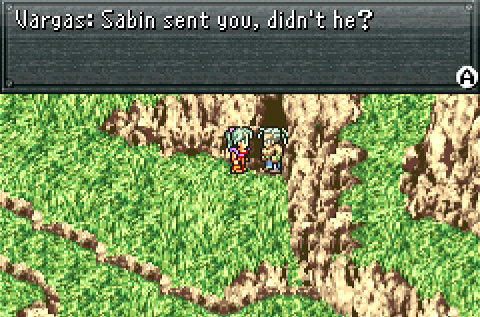
Near the exit from Mt. Kolts, a man stands in your way: The dungeon boss, Vargas.

This is a different battle than what’s come before, because Vargas himself is untouchable. He sends out a pair of trained bears (Ipoohs) as his frontline fighters, and they create an impenetrable wall between you and him. Physical attacks, magic, Tools, even Steal — it’s all intercepted by the Ipoohs.
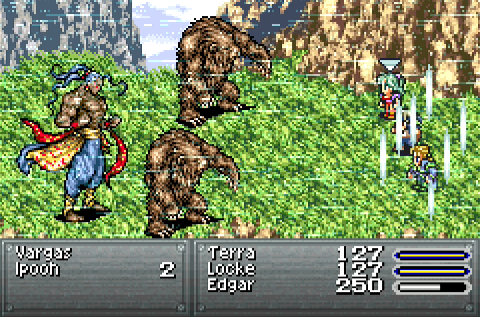
Well, the Ipoohs aren’t entirely impenetrable. Vargas has no trouble blasting your party despite the meat wall standing in front of him. His physical strikes have plenty of power, but his Gale Strike is especially devastating; it hits all three of your party members to devastating effect. But you can’t do anything about it until both Ipoohs are down.
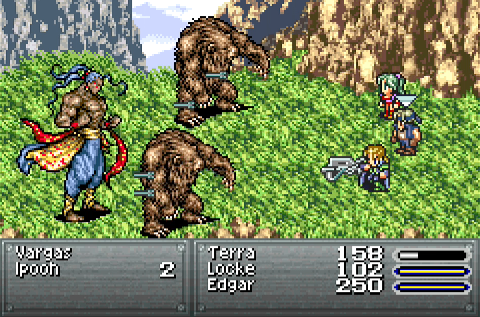
Thankfully, they take arrows quite well. Being boss-class characters, though, they’re immune to basically every kind of status effect (a standard state of affairs for bosses in RPGs not developed by Atlus), so you can’t do anything devious like Noiseblaster them to get them to turn on Vargas.

Once you have a clear shot at Vargas, you can dogpile him as you like. After he absorbs a few hundred hit points of damage, a cut scene begins. The mysterious shadow appears in the flesh, and — again, small game world — it turns out to be Edgar’s brother Sabin. This is what the hint about Edgar looking like Duncan’s pupil was about.
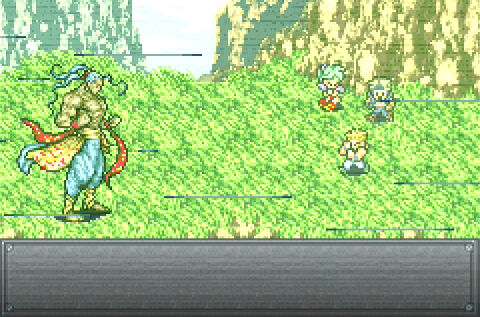
At this point, Vargas uses his Gale Strike to blast everyone but Sabin out of the party — in the middle of the fight, your playable team completely changes and you’re controlling a character you’ve never used before. That’s pretty bold! Unfortunately, this gambit isn’t pulled off quite as smoothly as it should be.
Incidentally, the trick Vargas pulls off here (blowing party members permanently out of combat) is something a number of enemies can perform throughout the game. It’s presented as a plot event here, but it actually is your first glimpse of one of the more devious mechanics you’ll face in FFVI.
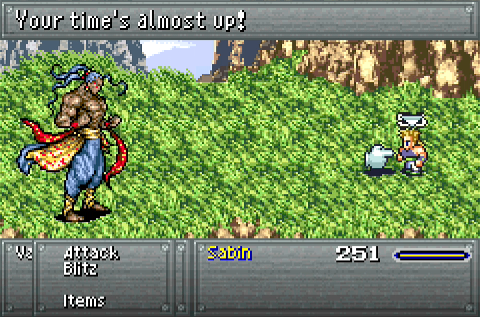
Once Sabin and Vargas face off mano a mano, your foe immediately uses a special technique called Doom Fist which initiates a one-minute timer for Sabin. This is one minute he has to defeat Vargas; when the countdown hits zero, Sabin dies. Vargas is pretty tough and you probably couldn’t beat him in a straight fight (he has a ton of hit points), but it’s a moot point because there’s no way to grind down his health before Doom Fist takes out Sabin. And since you’ve been reduced to a single party member, once he dies, it’s game over.
So what’s the secret to victory? You need to read dialogue cues to figure it out. Vargas is bitter because he thinks Duncan selected Sabin as the heir to his school of martial arts rather than his own son (that would be Vargas). So the secret is to use Sabin’s techniques versus Vargas’.
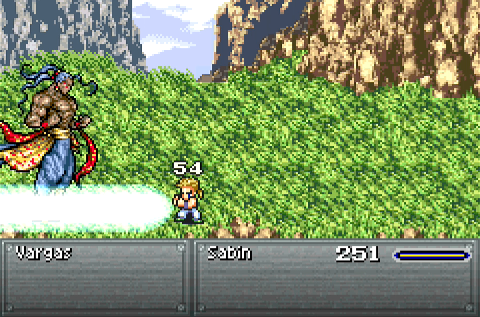
At the moment, Sabin knows two skills: Aurablast and Raging Fist. Aurablast is basically a Street Fighter hadouken… literally. Blitz attacks aren’t typical RPG command selections where you pick an action from a menu and it happens. Instead, you choose Blitz, input a button combination, and then press select to execute the command. If you blow it, you waste a turn. If you perform the inputs correctly, though, you’ll perform a powerful martial arts move for no cost.
Aurablast uses a hadouken command: Down, down-forward, forward. However, that won’t do anything for you. It’ll hurt Vargas, but not enough to win the fight.

Instead, you need to use the technique Raging Fist (forward, backward, forward). This actually hits for less damage than Aurablast, but it destroy’s Vargas right in his self-esteem. Devastated that dear ol’ dad taught Sabin this move but not Vargas, he crumbles and you instantly win the battle.
OK, cool. Dramatic intro to a new character, and an interesting way to introduce a new mechanic. Unfortunately, Square sort of bungles it here. This is an opaque, unintuitive conclusion to the battle; even if you take out the Ipoohs and Vargas perfectly, the second phase of the fight can cause you to lose simply for not knowing what to do or how to perform an action that isn’t explained, demonstrated, or presented in-game until your time has almost run out.
Not only that, it represents the first-ever change of input modality in a Final Fantasy game. Until this point, not only FFVI but the franchise as a whole has operated through menu-based actions. Blitzes, however, work with fighting game button combos. This is not explained in-game until Doom Fist runs down to around 20 seconds. Even then, it’s hard to intuit the precise method of using Blitzes, including the fact that you finish them off with an unprompted press of the confirmation button. You reach a story point in a boss fight that expects you to perform an unknown action in a style you’ve never seen before, at which point you’re expected to figure out how this new command technique works with enough time for two or three before your timer runs out. Frankly, it sucks.

On the other hand, victory results in Sabin joining your party. Finally, a traditional Final Fantasy class! Whose class skills are deeply unconventional. No status quo for this Final Fantasy, thank you.
“there’s no good reason to come back this way unless you really screw up with some of the one-way transit features within the world.”
Screw up, or use intentionally to get a rather rudely-placed, missable dance.
(Or pull the Lete River grinding trick, I suppose.)
No comment on what happens if you pay a visit to Duncan’s house before heading up to Mt. Kolts? I’m a little disappointed, Jeremy.
But yeah, unless you’ve read the manual or a guide the fighting game thing going on with Sabin’s moves will definitely be confusing. You just got the guy playable, and they already expect you to pull off his most basic move done in a way completely different from standard RPG combat.
This meant to be a design analysis, not a FAQ or trivia list.
Fair enough, I guess. I was just a little surprised that didn’t get a mention after how in depth you went on South Figaro.
Final Fantasy VI is full of li’l world-building scenes that can be easy to miss.
I could never reliably get the Blitzen involving diagonals to work until I found out that instead of pressing D and rolling through DF to F like it was SF2, you could just press D D F.
Great series Jeremy. I want to emphasize the fact that this game fits into 3 megabytes, without modern compression! The mp3 of one pop song at a mere 128 kbps would likely be larger. Talk about doing more with less!
Is the silhouette Sabin or Vargas? I always thought it was Vargas…
I know this is just graphical nitpicking, but I really like how Square used what appeared to be photographed elements in the backgrounds for this game. The outdoor mountain battle screen clearly displays four different layers of depth simply by varying the amount of atmospheric haze.
Compare the silhouette to the sprite — it’s definitely Sabin. Spiky hair, ponytail at the nape of his neck rather than sprouting from the back of his head.